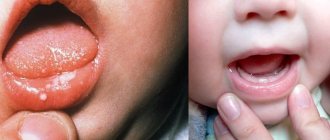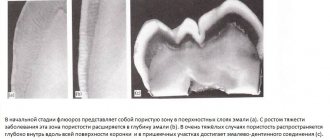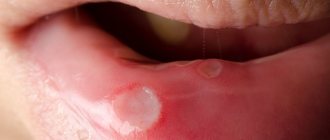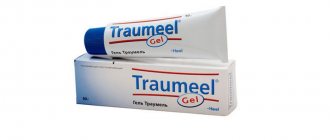Bubbles with yellowish contents on the mucous membrane of the cheeks, back of the tongue, and lips cause pain to the baby and are accompanied by drooling and low-grade fever. Active children become lethargic, sleep restlessly, and are capricious. This is how herpetic stomatitis manifests itself - damage to the mucous membrane provoked by the type I herpes virus. The disease is not dangerous if treated correctly. In the absence of medical supervision or self-medication, the symptoms disappear, but a chronic form may develop, laryngitis, and conjunctivitis may develop.
HERPETIC STOMATITIS IN CHILDREN: CAUSES, CLINIC, TREATMENT
Herpetic stomatitis is a viral disease that affects the oral mucosa and skin of the perioral area. It is considered as the body's primary response to contact with DNA-containing herpes simplex virus type I.
The disease is widespread in the structure of childhood pathology. It accounts for 80% of inflammatory diseases of the oral cavity. Most often, young children become ill (the peak incidence occurs at 1 year/2 years).
Causes:
- decreased maternal antibodies
- immaturity of the immune system
- highly contagious virus
- carriage in 90% of adults
- loose connective tissue
- thin epithelium up to 3 years of age
The virus enters the body through airborne droplets and household contact. The entrance gates are the skin and mucous membranes. Rapidly multiplying in tissues, viral cells rush into the bloodstream, and then into various organs and tissues, where they actively multiply with the development of secondary viremia.
Symptoms of herpetic stomatitis
The severity of acute syndrome is determined by the combination of the severity of mucosal lesions and general symptoms (fever, headache, vomiting). With herpetic stomatitis, there is no transition from stage to stage - either immediately mild, severe, or moderate. In children, general symptoms prevail over local ones; even with minor inflammation of the mucous membrane, low-grade fever and weakness are observed.
Mild form of OGS. The rash is preceded by a rise in temperature to 37.5°C. After 1–2 days, catarrhal gingivitis develops (swelling, darkening, bleeding in the gingival margin). Salivation increases, and the submandibular lymph nodes may enlarge. Against the background of inflammation of the gums, bubbles (up to 3-5 pieces) appear in the mouth, which quickly open and turn into small ulcers with a white coating and reddened edges. Herpetic stomatitis on the tongue causes pain when talking, chewing, children refuse to eat. The rash appears once. After 1–2 days, the temperature returns to normal, swelling of the gums, pain and burning in the mouth decrease. Erosion heals without scars within 5–7 days.
Moderate degree of AHS. The onset of the disease is indicated by a slight increase in temperature, physical malaise, soreness and hardening of the submandibular and cervical lymph nodes. After a day or two, the part of the gum surrounding the teeth swells, turns red and aches, and the temperature rises to 38℃. On the reddened mucous membrane of the mouth and the skin of the perioral area, blisters appear in the amount of 5–15 pieces; they can unite into large painful ulcers with pink outlines and reappear. How long it takes for a child to get herpetic stomatitis depends on immunity, timeliness and effectiveness of treatment. Typically, the peak period of the disease lasts 7–10 days. Without adequate treatment, a herpetic infection can spread to the conjunctiva of the eyes, and ulcerative gingivitis with bleeding erosions, damage to the oropharynx, and deformation of the gingival papillae can develop.
Severe form of OHS. It develops rarely, in most cases in children with immunodeficiency. Already at the beginning of the disease, the lymph nodes in the neck and under the jaw become inflamed, and the temperature rises to 40℃. The swollen mucous membrane bleeds; after a day, bubbles form in the oral cavity, near the lips. New rashes appear repeatedly, you can see a vesicular rash at different stages of healing, merging erosions. Recovery is long (14 days or more), herpetic stomatitis can become recurrent and periodically worsen.
If you notice a rash in your child’s mouth or lips, sign up for a consultation. Our pediatric dentists and periodontist will find a common language with the little patient and quickly alleviate the condition.
Acute herpetic stomatitis in children
The clinical picture of the disease is quite typical. The beginning is always sharp. Most often, the perioral area, lips, pharynx and the rest of the mucous membrane are secondarily affected. The course is mild, moderate and severe. After recovery, the virus often remains in the body, and the child is its carrier.
If treated improperly, the infection can become chronic with frequent exacerbations due to a decrease in general immunity, stress, vitamin deficiency, antibiotic therapy, after acute respiratory infections and even prolonged exposure to the sun.
How to treat herpetic stomatitis?
Treatment of herpetic stomatitis in children and adults can be general or local. The therapeutic treatment strategy is determined by the form and severity of the disease. In this case, the patient is usually shown:
- high-calorie diet, drinking plenty of fluids, bed rest;
- antiviral drugs (orally, intravenously or intramuscularly);
- restorative therapy (taking vitamins);
- symptomatic treatment (use of antipyretics, painkillers, anti-inflammatory drugs);
- local therapy (rinses, applications, etc.).
When choosing tactics for treating acute or chronic herpetic stomatitis in adults and children, it is important to correctly determine the form and stage of the disease. That is why experts urge patients not to self-medicate, but to immediately consult a doctor if signs of damage appear.
Therapy under the supervision of a specialist will allow you to recover quickly and without consequences for the body. With the right approach, herpes stomatitis in a child or adult can be cured in 10-14 days.
Clinical picture
Primary acute and chronic recurrent herpetic stomatitis is an infection that causes suppression of the immune system. Therefore, it should not be ignored.
The first symptom of the disease is anxiety. This is followed by whims, crying, refusal to eat, poor sleep. Increased salivation occurs, symptoms of intoxication - temperature 38-40°C, chills, complaints of nausea, sensitivity of regional lymph nodes.
The child complains of feeling unwell, and there are catarrhal manifestations - runny nose, cough. Sometimes the virus causes inflammation of the conjunctiva. From the oral cavity, herpetic stomatitis manifests itself as swelling, redness and bleeding of the gums.
Groups of small (2-3 mm) vesicles—liquid-filled bubbles—appear on the hard and soft palate, lips, tongue, and even around the mouth. When their thin shell bursts, they form areas of erosion that are prone to bleeding.
Herpes can also be aphthous, and aphthae with a whitish coating can be adjacent to erosions. Painful rashes at this stage bring excruciating suffering. If left untreated, secondary infection and suppuration are possible.
Symptoms
The duration of the latent (incubation) period for the development of herpetic stomatitis is 2-14 days. The prodromal period immediately preceding the disease is characterized by:
- restless behavior of the child;
- whims;
- sleep disorder;
- loss of appetite.
The lymph nodes, cervical and submandibular, enlarge and become painful. Salivation increases, the child feels nauseous, and attacks of vomiting occur.
Intoxication of the body with herpetic lesions manifests itself acutely:
- the child has a fever;
- temperature rises to 38-40°C;
- he feels weak, broken;
- possible inflammation, bleeding of the gums, pain and burning in the mouth;
- the mucous membrane of the mouth becomes covered with bursting blisters (2-3 mm) - herpetic eruptions. This lasts 2-4 days and is extremely painful.
Treatment
The treatment process for herpetic stomatitis is a complex task. Its main goals:
- Suppression of viremia
- Relief of general condition
- Reduced likelihood of complications
Treatment is selected based on the severity, current period and severity of symptoms:
- General. Taking drugs that have a systemic effect: In the acute period , antiviral etiotropic (acyclovir), anti-inflammatory, antihistamine, immunomodulatory (interferon) drugs, and vitamins are prescribed.
- In remission, courses of vitamin therapy and a high-calorie diet are recommended.
For mild to moderate cases, the child is treated on an outpatient basis. In case of severe manifestations or the addition of a secondary infection, especially in children under one year of age, hospitalization in a hospital may be recommended.
Clinical recommendations:
- drinking plenty of fluids
- proper diet
- bed rest
To prevent exacerbations, it is very important to harden yourself and play sports. Isolate the child from contact to prevent mass infection.
Treatment of herpetic stomatitis at the “Family Dentist”
Therapy for OHS is complex; in mild to moderate cases, it is carried out at home. The dentist prescribes medications, gives recommendations on nutrition and oral hygiene. The cost of an appointment in our clinic is from 10 rubles.
When herpetic stomatitis is diagnosed in children, the treatment regimen includes:
- Diet. Food should be liquid or semi-liquid (mashed soups, vegetable purees, cereals, jelly, yoghurts, minced meat and fish) at a comfortable temperature. In case of extensive erosions, it is advisable to feed the baby liquid food through a tube.
- Prevention of dehydration. Water balance is maintained with dried fruit compotes, broths, plain water, and a weak rosehip decoction.
- Oral hygiene. To prevent the development of a secondary infection, teeth should be cleaned with a soft brush without paste, and the mucous membrane should be treated with a swab and a warm antiseptic solution. You should rinse your mouth every time after eating.
- Local, general therapy. The drugs are prescribed by the dentist, taking into account the severity of the acute syndrome.
Mild degree. Ulcerations of the mucous membrane are treated 3-4 times a day with a cotton pad or bandage soaked in a solution of chlorhexidine 0.05% or miramistin. If necessary, the doctor prescribes an antiviral ointment. If there is no risk of seizures, antipyretic drugs are not prescribed.
Moderate degree. At the height of herpetic stomatitis, treatment with local antiseptic solutions is supplemented with tableted antiherpetic drugs, if the rash does not begin to dry out on the 2nd–3rd day. Medicines have an effect on the entire body, therefore they are taken only as prescribed by a doctor. The mucous membrane after a viral infection is restored with healing agents with vitamins A, E, and sea buckthorn oil. To reduce pain, lidocaine gel is applied to the mucous membrane 20 minutes before meals.
Severe degree. The dentist refers you to the hospital, treatment is carried out with injectable drugs, immunostimulants, and physiotherapy is prescribed.
To make an appointment at the “Family Dentist” in Minsk, fill out the form or call. You don't have to stand in line with a sick child.
Prevention
To avoid illness, specialists from the Novostom innovation center advise:
- strengthen the immune system; wash your hands with soap often;
- have less contact with sick people;
- do not injure the oral mucosa.
When the first symptoms appear, you should take your child to the dentist in order to begin treatment on time.
The article was prepared by an expert:
Gomonova Ekaterina Nikolaevna
Children's dentist
Make an appointment
Types of stomatitis
- Herpetic. The mucous membrane becomes irritated and bubbles filled with liquid form. The temperature may rise, your head will feel dizzy, you will begin to shiver, or other signs of ARVI will appear;
- aphthous is accompanied by the appearance of ulcers ranging in size from five millimeters to a centimeter. A maximum of three ulcers can form on the sides of the tongue, inside the cheeks or lips;
- fungal occurs due to Condida fungus. A persistent white coating appears because breast milk promotes the growth of the fungus. Children under one year of age become ill;
- allergic. The tongue and gums turn red, there may not be a fever, but after a while this type can develop into another more serious type of disease;
- bacterial occurs during teething in children. It can also occur when causing injuries to the oral cavity. Injuries can be either mechanical or thermal. With poor hygiene, the risk of this disease is also high.











